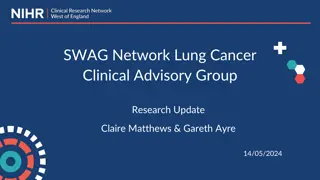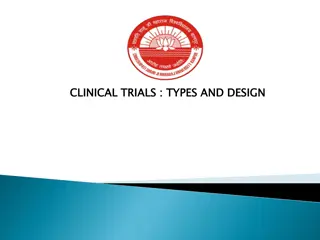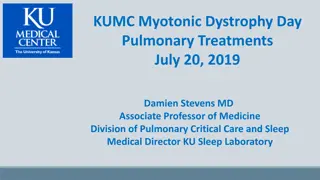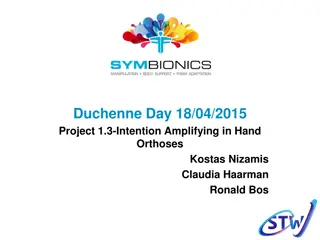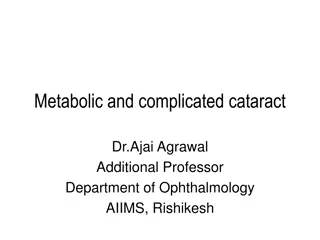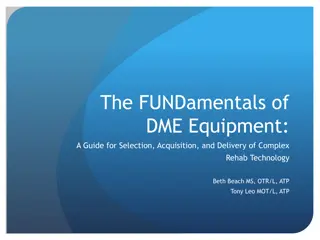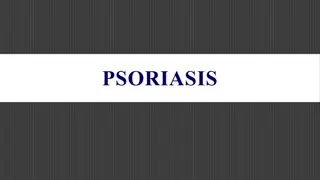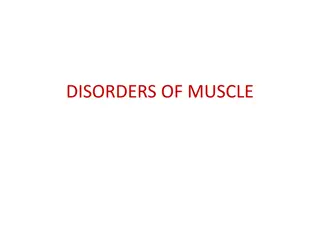Understanding Research Studies in Myotonic Dystrophy
Delve into the world of Myotonic Dystrophy research through this informative content, exploring different types of research studies, phases of drug trials, and the importance of informed consent. Learn about observational and interventional studies, drug trial phases, and the intricate process involved in advancing medical knowledge in the field of Myotonic Dystrophy.
Download Presentation

Please find below an Image/Link to download the presentation.
The content on the website is provided AS IS for your information and personal use only. It may not be sold, licensed, or shared on other websites without obtaining consent from the author. Download presentation by click this link. If you encounter any issues during the download, it is possible that the publisher has removed the file from their server.
E N D
Presentation Transcript
Myotonic Dystrophy Research: What s Next Peg Nopoulos, M.D. Professor of Psychiatry Ian DeVolder, PhD, MDF Postdoctoral Fellow
Research In Myotonic Dystrophy (DM) https://cdn.thinglink.me/api/image/439768539239284737/1240/10/scaletowidth Types of Human Research Studies Should I volunteer for a research study? Studies available for Myotonic Dystrophy
Types of Research Studies Naturalistic or Observational NO intervention no drug or therapy is being tested Study gathers data on signs and symptoms and biologic or body function measures Thinking skills tasks Motor skills; muscle strength Measures of behavioral or psychiatric issues Measures of physiology / measures of structure o Electromyography (EMG) muscle function o Magnetic Brain Imaging (MRI) muscle or brain structure (volume of certain regions) Biologic samples o Blood for DNA, proteins o Cerebral Spinal Fluid (CSF) called a spinal tap Assessments are often done more than once annual or every other year
Types of Research Studies Interventional This is a treatment trial oEither a drug or some other type of intervention (for example exercise) to see if it has an effect on the disease Experimental Drug
Informed Consent This means that you have been given all of the information on the study and you Understand all parts of the study Giving your permission to be a study subject You can always change your mind
Phases of a Drug Trial FDA Approval Pre- Clinical Phase 1 Phase 2 Phase 3 Phase 4 MONITOR Drug now in use by the Public Study the drug in ANIMALS Test for SAFETY 20-100 subjects What dose? EFFICACY Does it work? 100-500 patients CONFIRM >1,000 patients Compare to other treatments About 4 years 2-3 years 2-3 years 2-3 years
Research In Myotonic Dystrophy https://upload.wikimedia.org/wikipedia/en/7/78/Human_Research_Program_2012_(logo).jpg Types of Human Research Studies Should I volunteer for a research study? Studies available for Myotonic Dystrophy
Should I Volunteer for a Research Study? Personal choice! You volunteer your time If you are under 18, both you and one of your parents have to agree to be in the study Balance of risk and benefit For an observational study, NO BENEFIT to the person participating. It may help people in the future. Typically LOW RISK Often there is money provided to help with travel to the study site, meals, and also some as compensation for your time For an interventional study HIGH RISK, potential HIGH BENEFIT
Research In Myotonic Dystrophy https://upload.wikimedia.org/wikipedia/en/7/78/Human_Research_Program_2012_(logo).jpg Types of Human Research Studies Should I volunteer for a research study? Studies available for Myotonic Dystrophy
Research In Myotonic Dystrophy https://upload.wikimedia.org/wikipedia/en/7/78/Human_Research_Program_2012_(logo).jpg Myotonic Dystrophy Foundation (MDF) Website Research / Study & Trial Resource Center
Gene Therapy GENE THERAPY (also called Gene Silencing) Myotonic Dystrophy caused by ONE GENE http://web.stanford.edu/group/hopes/cgi-bin/hopes_test/wp-content/uploads/2012/04/genesilencing.jpg mRNA = messenger RNA is toxic Get rid of this toxic mRNA
Gene Therapy GENE THERAPY IONIS-DMPKRx Targets the toxic RNA of DM1 Given as a sub-cutaneous or just under the skin shot Phase I trials completed no safety concerns Phase II Trial In January 2017 they announced that there was variability in how much of the drug got into the muscle o In some people, it worked really well, in others, not so well So the trial has ended for now However IONIS is working on a new kind of drug (LICA) This drug will get into muscle better
Biomarkers and Outcome Measures What is a biomarker or outcome Measure and why are they important? Myotonic Dystrophy is a progressive disease degenerative This means worse over time The primary goal of gene therapy is to prevent progression A drug that protects against progression
Biomarkers and Outcome Measures Example of progression over time muscle strength Normal Aging DM1 Untreated 0 1 2 3 Time (in years)
Biomarkers and Outcome Measures Example of progression over time muscle strength We want the drug to stop progression of muscle strength Normal Aging DM1 Untreated DM1 treated with a protective drug 0 1 2 3 Time (in years)
Biomarkers and Outcome Measures Example of progression over time muscle strength We want the drug to stop progression of muscle strength So we measure muscle strength over time outcome measure At 2 years out, the untreated patient has muscle strength of roughly 70 while the treated patient has almost 80 80 Normal Aging DM1 Untreated Outcome Measure 70 Begin Drug DM1 treated with a protective drug 60 50 40 Evaluation Time Points: Does drug alter disease course? 30 0 1 2 3 Time (in years)
Biomarkers Biomarker a biologic measure of disease progression Often, biologic changes happen way before symptoms They may be more sensitive to changes in disease progression Example: measure of toxic RNA 80 Normal Aging DM1 Untreated 70 Biomarker Begin Drug DM1 treated with a protective drug 60 50 40 Evaluation Time Points: Does drug alter disease course? 30 0 1 2 3 Time (in years)




